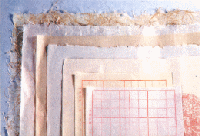 Ink stick
Ink stick
 The ink stick is a unique pigment of Chinese traditional painting and calligraphy. At the initial stage natural ink or half-natural ink was generally used. It was during the Han that artificial ink appeared. At that time the most famous ink-stick was "Yumi-mo" produced at Qianyang, Shaanxi. The raw materials of ink stick were pine, oil and lacquer.
The ink stick is a unique pigment of Chinese traditional painting and calligraphy. At the initial stage natural ink or half-natural ink was generally used. It was during the Han that artificial ink appeared. At that time the most famous ink-stick was "Yumi-mo" produced at Qianyang, Shaanxi. The raw materials of ink stick were pine, oil and lacquer.
Before theFive Dynastiesthe ink-producing center was in the North, then it reached the South. The most celebrated South ink-stick was "Hui mo", which was produced in Huizhou ofAnhui Province.
 Paper
Paper
 Paper is one of the four famous Chinese inventions. It is widely accepted that paper was invented by Cai Lun in the EasternHan Dynasty(25-220) . However the archaeologists have discovered paper of Western Han such as "Fang-ma-tan" paper, "Ba-quao" paper, "Xuan-quan" paper, "Ma-quan-wan" paper, "Ju-yan" paper and "Han-tan-po" paper.
Paper is one of the four famous Chinese inventions. It is widely accepted that paper was invented by Cai Lun in the EasternHan Dynasty(25-220) . However the archaeologists have discovered paper of Western Han such as "Fang-ma-tan" paper, "Ba-quao" paper, "Xuan-quan" paper, "Ma-quan-wan" paper, "Ju-yan" paper and "Han-tan-po" paper.
After theEastern Jin Dynasty, paper was extensively used instead of traditional writing materials such as bamboo slips and silks. Various methods of producing paper emerged one after another.
In the Tang and Song Dynasties, the paper producing industry thrived, with the appearance of
many quality products. During theQing Dynasty, "Xuan zhi (xuan paper)" produced in Jing
Prefecture of Anhui (Xuanzhou) Province became the special paper for painting and calligraphy,
and was regarded as "the king of paper."
